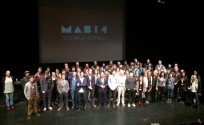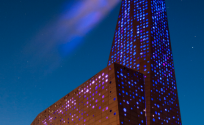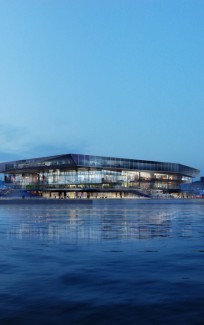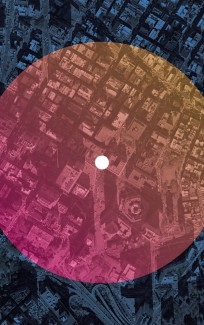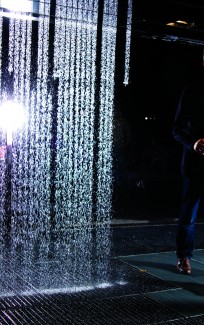Beyond things that flicker
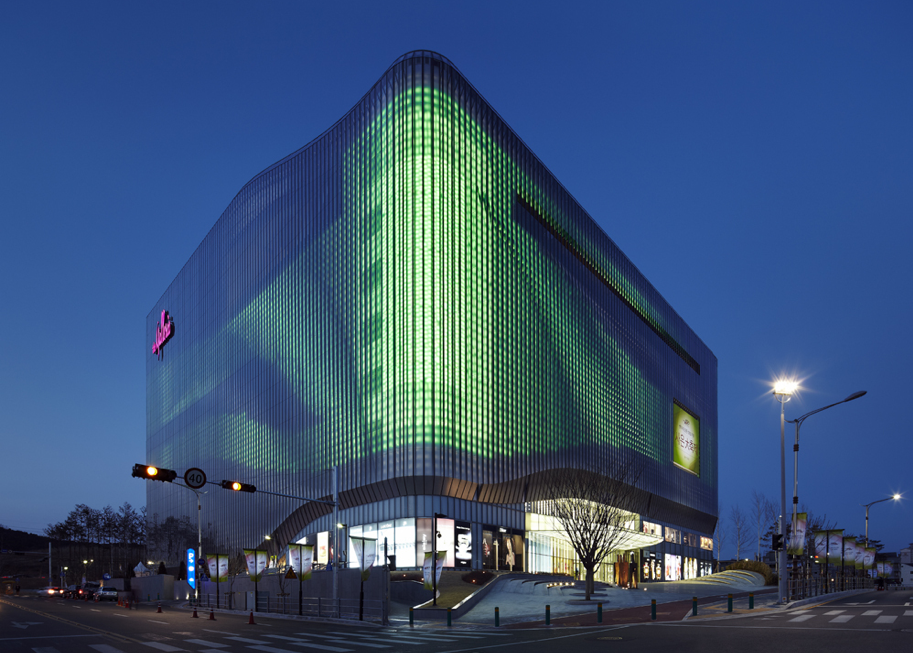
A Decade of Mapping the Senseable City: A world premiere of the collected work from MIT Senseable City Lab. A project by Carlo Ratti, Antoine Picon, Matthew Claudel and the MIT Senseable City Lab for the 2014 Media Architecture Biennale Aarhus, Denmark.
![]() This post is written for MAB14 by Matthew Claudel, a researcher at MIT’s Senseable City Lab, where he works on a broad spectrum of projects in the fields of design, writing, architecture, art and technology. It was also published on archdaily.com
This post is written for MAB14 by Matthew Claudel, a researcher at MIT’s Senseable City Lab, where he works on a broad spectrum of projects in the fields of design, writing, architecture, art and technology. It was also published on archdaily.com
The Actuated Cathedral
Media architecture is emphatically ambiguous. The phrase has been pasted wholesale onto a dizzying array of projects and products. But beyond imprecision, media architecture is vexed by an inherent tension: media are networked, immediate, dynamic communication systems that reach people broadly, while architecture is sited, singular, and persistent in time. Reconciling the two evokes clumsy associations with Times Square, screens, integrated LEDs, paparazzi, or more generally things that flicker.
The word ‘media’ was appropriated (and impoverished) by broadcasting and communications in the course of their pervasion during the 20th century. As a new social phenomenon, media (along with its derivatives new media, multi media, mass media) was eagerly studied by the emergent figure of the ‘media theorist.’ Marshall McLuhan, pioneer of the field, categorically dismissed content, focusing instead on the potency of the networked transmission system itself. Media, for McLuhan, was not about information, but about tools of content delivery, the intermediaries between providers and consumers. [2] His reading points to a broader, prior definition of media as simply the things-in-between, diplomatic structures, membranes that negotiate two conditions or entities.
That is, architecture.
The simplest definition of a building is ‘that which mediates’ between humans and their climatic or social environments. Separating interior space from the elements, creating a thermal or liquid envelope around human bodies, is the most basic function of a building. Beyond shelter, architecture also implicates a cultural dimension, as a device for communicating social relationships – for example, a palace mediating between ruler and subjects, or a cathedral mediating between God and man.
Architecture negotiates spatial, environmental and social discrepancies, creating unique conditions that impact human behavior. Upon entering a vaulted cathedral, for example, visitors shuffle to the periphery but remain oriented towards the altar, lower their voices, and restrict their movements, all while casting their eyes furtively upward. Cathedrals mediate a complex array of socio-climatic conditions, eliciting a nearly-universal behavioral response.
Tomorrow’s dynamic actuated architecture, with a heady transfusion of digital technologies, has the capacity to operate at the scale and the pace of 21st century telecommunications networks. But if it will be anything more than oversized television screens, (prey to the economic trap of building-scale advertisement already familiar across the streets of Seoul, New York, Tokyo) it must engage architecture’s historic capacity of environmental, spatial, and social haptic experience. That is, addressing the human body and its dimensional relationships. “Architecture articulates the experiences of being-in-the-world and strengthens our sense of reality and self,” contends Pallasmaa, “it does not make us inhabit worlds of mere fabrication and fantasy,” [3]… media architecture no less, despite the seduction of ‘worlds of fantasy.’ Furthermore, the emotional negotiation between interior / exterior, and public / private must be actively addressed. While the haptic experience of a cathedral is strongly interiorized, the dynamic sensorial potency of media architecture can be a responsive choreography of external and internal. It will address immediate surroundings and global networks, with direct impact on human perception and behavior.
Mapping Perception
That architecture will become more technology-integrated is a given, and as it matures, the operation and the scope of impact of digital elements can develop along different paths. At a turning point in the practice, ‘media architects’ are responsible for articulating the breadth of perceptual domains that their mediation-structures (buildings) will address – whether visual or auditory, tactile or hydrological. Practitioners at the forefront of media architecture are moving along the same general vector, towards manipulating a broader range of environmental stimuli, active building response, and integrated networks, but there is a problematic bifurcation when it comes to tangible instances.
Of the projects that exist today – the pioneering Institute du Monde Arabe, the Galleria Centercity from UNstudio, the NOVA installation by ETH in the Zurich Train Station, ARUP’s crystalline adaptive surface outfitting the Abu Dhabi Investment Council Headquarters Towers, and dozens more – the vast majority of realized work deals exclusively with light. A scant minority addresses a broader scope of human, haptic and environmental parameters, and – by no coincidence – this divide maps cleanly onto the (long-standing) fault line between artistic and commercial application.
Why light? Quite simply, it is understood. Light is measurable and its effects are quantifiable, with direct economic consequences. Futuristic lighting and shading technologies are marketable both in terms of green-rhetoric and efficiency, and they can even integrate with existing HVAC systems. It is a clear choice in the private sector. For example – despite its promising name – The Adaptive Building Initiative seeks merely to “control light levels, solar gain, and thermal performance, ABI’s adaptive systems reduce energy usage, enhance comfort, and increase the flexibility of the built environment.” [4]
Outside of lighting strategies, the industry struggles to bridge the gap between aesthetic and commercial value. Spatially and haptically dynamic architecture continues to progress slowly and haphazardly. Experimentation at the cutting edge is beginning to show the possibilities of true media architecture, but not the implications. And that is where development is stymied.
Haptic experience is largely uncharted, in a scientific sense, yet widespread adoption of truly meaningful media architecture hinges on research and deeper understanding of spatial perception. We simply do not know how humans respond to a variety of environmental stimuli. Artists like Olafur Eliasson have an uncanny sense of it – a sense that lends their projects a visceral power – but scientists do not. Artistic or speculative projects are the random mutations, shots in the dark, often with exciting but erratic results. The kernels of an emerging paradigm can be seen in projects like Heatherwick Studio’s Rolling Bridge, in dECOi’s Hyposurface of shifting pixels, and the Senseable City Lab’s Local Warming. Yet the burden, today, is on researchers to engage a process of scientific investigation of haptic response. Without a rigorous understanding of how humans perceive and inhabit space, technologies that address that condition are at best an inexplicable success and at worst a decisive failure.
At its most compelling, media architecture will elicit behavioral transformations on the order of a cathedral, but dynamically, immediately and responsively: the fundamental associations between human body, space and networks will be reconfigured. This reconfiguration implicates four elements – human perception, human behavior, sensing technologies, actuated environments. True media architecture will close the feedback loop between those, as people actively participate in space. “It makes a difference whether you have a body that feels a part of a space, rather than having a body which is just in front of a picture… there is a sense of consequences.” [5] For media architecture to gain traction and be confidently implemented, that ‘sense’ must be understood. The elements of dynamic spatial experience should be studied rigorously in isolation and as a system, to arrive at a perceptual model – and only then can media architecture technologies be realized in an informed way. The challenge, as media architecture matures, will be to ignite haptic consequences in a meaningful and systematic way, beyond artistic experiments or flickering images across the built environment.
References
[1] mediaarchitecture.com
[2] McLuhan, Marshall. Understanding Media: the Extensions of Man. 1964.
[3] Pallasmaa, Juhani. The Eyes of the Skin: Architecture and the Senses. 1996.
[4] Adaptive Building Initiative Website
[5] TED Talk by Olafur Eliasson
